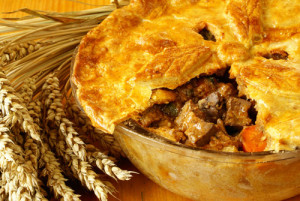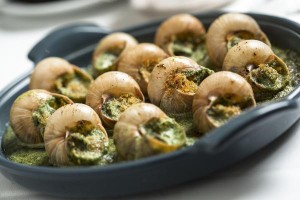The vast array of foods Americans find ‘yucky’ never ceases to amaze me. An admittedly unscientific survey I recently conducted indicates that a sizeable number, given their druthers, would subsist solely on pizza–and cheese pizza at that, unsullied by ‘yucky stuff’ like pepperoni, sausage and mushrooms.
There’s nothing new about this. It’s been going on for decades. Forty years or so ago, for instance, two of our nieces turned up their pretty little noses at a Thanksgiving dinner prepared by my wife.
Charlotte, who seems to be made of sterner stuff than many mothers, refused to take ‘yuck’ for an answer and insisted they try more than a mouthful of everything on their plates. Amid wails and protestations, they reluctantly sampled the stuffing and giblet gravy.
After a few tentative bites, one snivelled to the other: ‘Actually, this yucky stuff tastes really good!’
Since then their palates have broadened somewhat—I like to think, due in large part to Charlotte’s cooking.
We cannot claim too profound a victory, however—inasmuch as a couple of years ago one of them phoned Charlotte to find out how to cook fresh green beans.
Things were very much different when I was a child. Wartime rationing continued in Britain, where I was raised, into the 1950s. Back then, there was no such thing as ‘yucky’ food. Most foodstuffs were in short supply at one time or another, so you ate what was set before you or went hungry.
The experience served me well. In my time, I’ve eaten a wide range of comestibles—animal, vegetable and, occasionally, mineral (primarily rock salt and sea salt). And quite a bit of it would not, I imagine, appeal to today’s American palate, infant or adult.
I’d wager there are not many Americans who would cheerfully tuck-in to rat or snake. And even I would probably balk at Australian aboriginal delicacies like witchetty grubs … unless I was really hungry.
But liver, kidneys, brains, heart, pigs’ trotters, ox tail, and, occasionally, tripe—all of which were rationed—were a regular part of our diet when I was a boy.
Rabbit and pigeon were not rationed, and you could serve up as many as you could catch, trap, or shoot. Consequently, they frequently featured on the menu—roasted, casseroled, stewed, or in a pie.
My grandfather-in-law, who lived in St Louis, Missouri, frequently dined on pigeon in the guise of ‘squab under glass,’ but I’ve never much fancied American pigeons. They look too small and scrawny. British pigeons, by contrast, are big, well-muscled birds that will comfortably feed two.
(To be quite frank, my experience of American pigeons is quite limited. It is largely confined to an acquaintanceship with old Italian guy who, back in the 1970s and 80s, would round up Manhattan pigeons and stash them in the back of an ancient Ford station wagon.
He was frequently questioned by New York’s finest, who suspected him of illegally selling them to restaurants. They were, however, never able to pin anything on him, because the old rascal was actually taking the birds back to Queens, where he sold them to gullible youngsters as homing pigeons.)
British gypsies cooked pigeons by wrapping them up in the clay that accounts for much of the soil in East Anglia and baking them for hours under an open fire. When they broke open the clay, the feathers came off with it, leaving the flesh ready to eat.

Steak and kidney pie (Source: johnpenny.co.uk)
My friends and I tried cooking pigeons by the gypsy method on a couple of occasions. But we were too impatient to leave them baking long enough under the fire. Pigeon cooked rare is edible but far from appetising.
We also attempted to cook a hedgehog in the gypsy manner, but the pitiful little creature looked at us so reproachfully, we let it go. Instead we lunched on half-raw potatoes baked in the fire we’d prepared for the hedgehog. They didn’t taste quite as bad as rare pigeon.
Lamb or pig’s liver and kidneys were in a different class altogether. Liver, braised with onions and, when you could find it, bacon, were great delicacies. But nothing could equal that glorious culinary triumph: the steak and kidney pie.
A steak, kidney, and oyster pie was, to my mind, even more delectable. But lamentably, steak and kidneys were rarely available at the same time. Oysters were easier to find, but rarely at the same time as kidneys.
Ox liver and kidneys were generally considered to taste a tad on the strong side, but if this is all that was on offer at the butcher’s, they were snapped up (forgive the pun) in a heartbeat. That said, a casserole of stuffed ox-heart often made a favourite winter dinner.
I must confess that tripe didn’t come high on my list of comestibles. Cooked in bacon fat with plenty of onions, it was tolerable, albeit reminiscent of warm chewing gum. Served cold, accompanied solely by salt, pepper, and vinegar, it was on a par with eating my dad’s leather flying jacket.
It wasn’t until an elderly French lady—a heroine of the Resistance who moved to our village after the War—cooked for us tripes à la mode de Caen that I could appreciate its finer points, culinarily speaking,

Escargot (Source: mezing-vn)
‘You can’t say you don’t like them until you’ve tried them,’ she declared, serving them up, cooked in their shells with butter, parsley, and garlic. One taste and we were hooked for life.
What prompted this musing was the mutual affection for kidneys that Father Hawks and I share. Recently I located an amazingly inexpensive supply at a local street market. Wiley proposed cooking them in the French manner in mustard sauce. Delicious!
‘Would you like to join us?’ Wiley asked Charlotte.
‘No!’ she replied emphatically.


